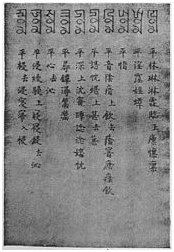Old Mandarin

After the fall of the Northern Song dynasty, northern China was under the control of the Jin (Jurchen) and Yuan (Mongol) dynasties. During this period, a new common speech developed, based on the dialects of the North China Plain around the capital, a language referred to as Old Mandarin. New genres of vernacular literature were based on this language, including verse, drama and story forms.
The rhyming conventions of the new verse were codified in a rhyme dictionary called the Zhongyuan Yinyun (1324). A radical departure from the rhyme table tradition that had evolved over the previous centuries, this dictionary contains a wealth of information on the phonology of Old Mandarin. Further sources are the ‘Phags-pa script based on the Tibetan alphabet, which was used to write several of the languages of the Mongol empire, including Chinese, and the Menggu Ziyun, a rhyme dictionary based on ‘Phags-pa. The rhyme books differ in some details, but overall show many of the features characteristic of modern Mandarin dialects, such as the reduction and disappearance of final stop consonants and the reorganization of the Middle Chinese tones.



Latest Comments